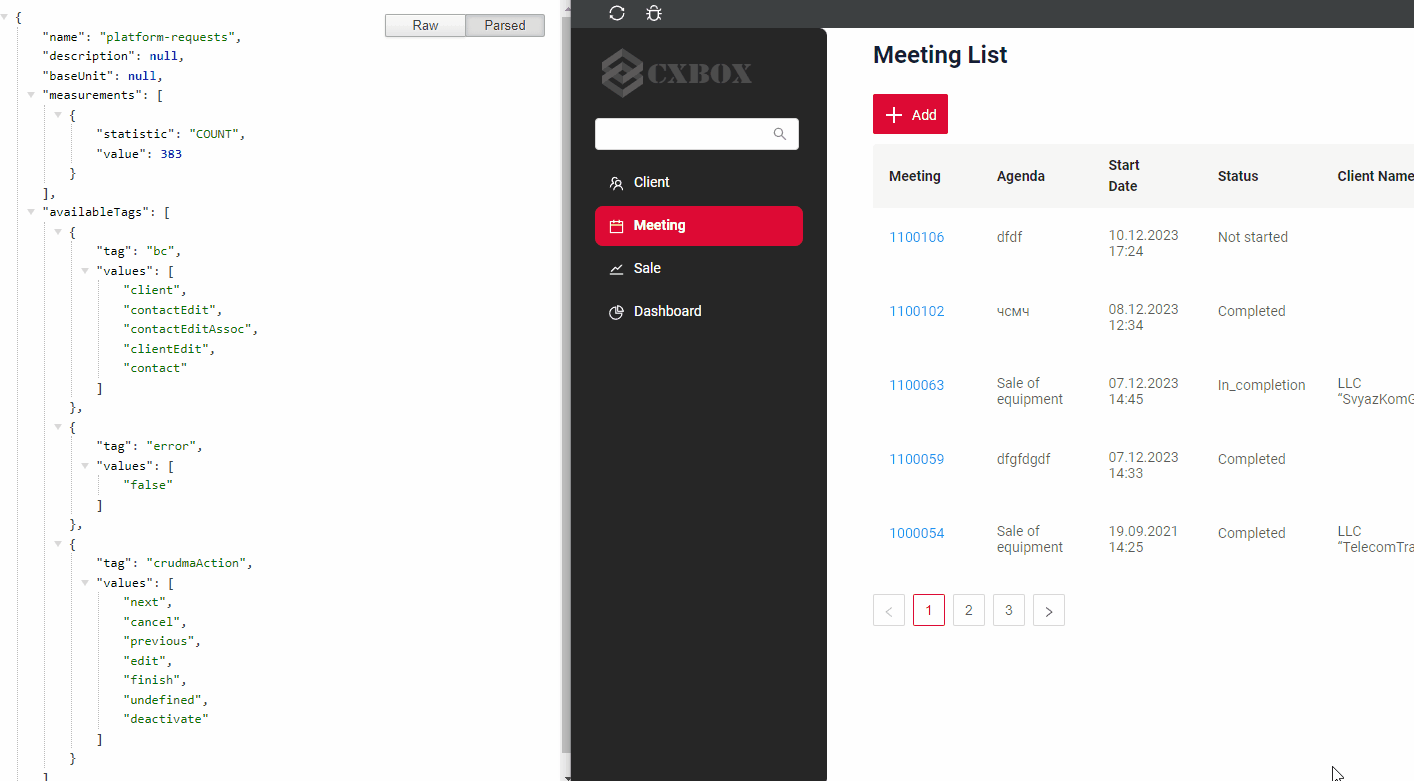Perfomance metrics
cxbox/core 3.0.5
cxbox-ui/core 1.37.1
How does it look?

Metrics
Metrics can be two types:
- Standard
- Custom
Standard metrics
Description Standard metrics see spring-boot metrics
How to add?
Example
Step 1. Add pom.xml new dependency.
Step 2. Add permission to SecurityConfig.java Step 3. Add new environment to application.ymlCustom metrics
You can see the number of requests in different sections.
Live Sample Statistics of all requests to UI
Live Sample Statistics of all requests to screen clients and user
Example request:
../actuator/metrics/platform-requests?tag=<section name>:<section value>
http://demo.cxbox.org/actuator/metrics/platform-requests?tag=screen:clientAll requests to screen clients
You can filter by several sections at once.
http://demo.cxbox.org/actuator/metrics/platform-requests?tag=screen:client&tag=user:JOHN%20SNOW All requests to user and screen clients
How does it look?
Custom application metrics: counting calls to UI tesler.

Custom application metrics: counting calls to screen clients.

How to add?
Example
Step 1. Add pom.xml new dependency.
<dependency>
<groupId>org.springframework.boot</groupId>
<artifactId>spring-boot-starter-actuator</artifactId>
</dependency>
management:
endpoint:
metrics:
enabled: true
endpoints:
enabled-by-default: true
web:
exposure:
include: 'metrics'
Custom metrics start name: "platform-requests"
package org.demo.conf.cxbox.metrics;
import io.micrometer.core.instrument.Counter;
import io.micrometer.core.instrument.MeterRegistry;
import java.util.Optional;
import java.util.stream.Stream;
import org.cxbox.core.crudma.CrudmaActionHolder.CrudmaAction;
import org.cxbox.core.crudma.CrudmaEvent;
import org.cxbox.core.crudma.bc.BusinessComponent;
import org.demo.conf.security.cxboxkeycloak.CxboxKeycloakAccount;
import org.springframework.context.ApplicationListener;
import org.springframework.security.core.Authentication;
import org.springframework.security.core.context.SecurityContext;
import org.springframework.security.core.context.SecurityContextHolder;
import org.springframework.stereotype.Component;
@Component
public class CrudmaEventListener implements ApplicationListener<CrudmaEvent> {
public static final String UNDEFINED = "undefined";
private final MeterRegistry registry;
public CrudmaEventListener(MeterRegistry registry) {
this.registry = registry;
registry.counter("platform-requests");
}
@Override
public final void onApplicationEvent(final CrudmaEvent event) {
final CrudmaAction crudmaAction = event.getCrudmaAction();
final BusinessComponent bc = crudmaAction.getBc();
Counter counter = registry.counter(
"platform-requests",
"screen", Optional.ofNullable(bc.getHierarchy().getScreenName()).orElse(UNDEFINED),
"bc", Optional.ofNullable(bc.getName()).orElse(UNDEFINED),
"crudmaAction", Optional.ofNullable(crudmaAction.getName()).orElse(UNDEFINED),
"user", Optional.ofNullable(getUserLogin()).orElse(UNDEFINED),
"error", event.getException() == null ? "false" : "true"
);
counter.increment();
}
public static String getUserLogin() {
return Stream.of(SecurityContextHolder.getContext())
.map(SecurityContext::getAuthentication)
.map(Authentication::getDetails)
.filter(CxboxKeycloakAccount.class::isInstance)
.map(CxboxKeycloakAccount.class::cast)
.findFirst()
.map(CxboxKeycloakAccount::getUsername)
.orElse(null);
}
}